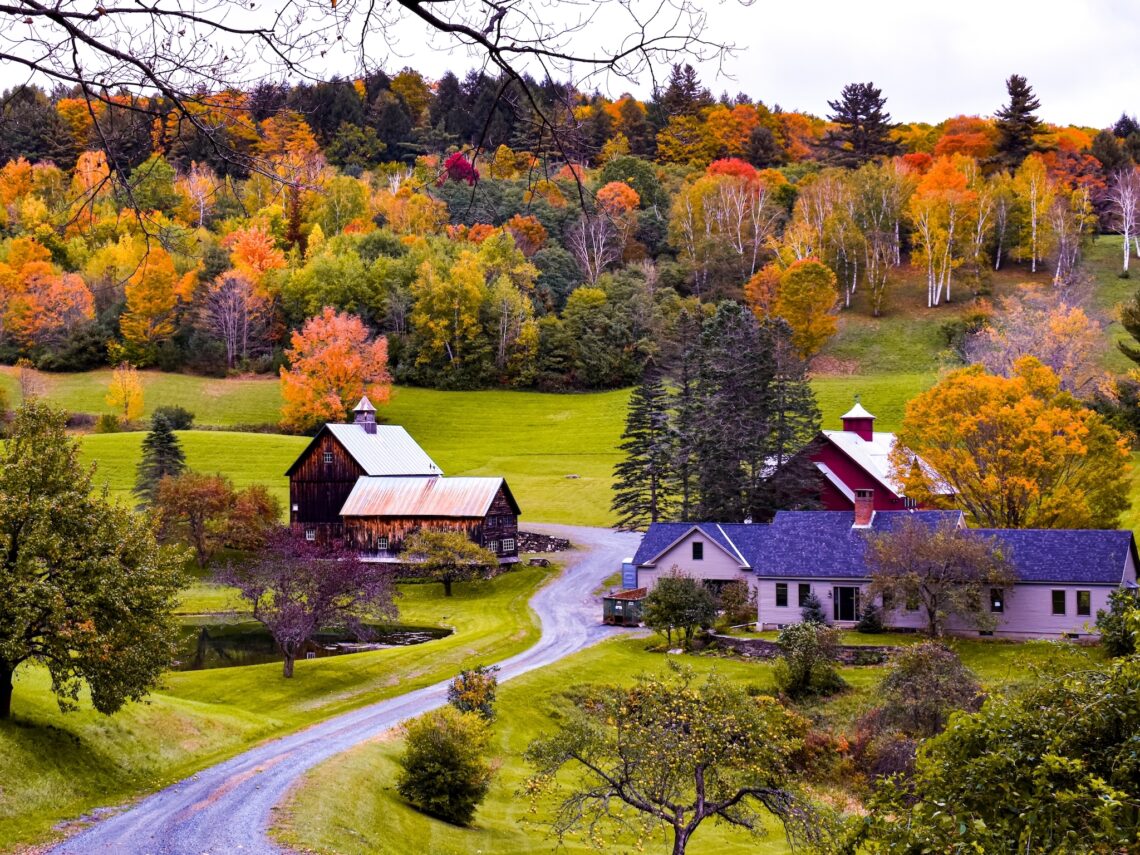A Quiet Town Overwhelmed by Autumn’s Charm
Nestled in the rolling hills of Vermont, Pomfret is a small town of about 900 residents, known for its serene landscapes and vibrant fall foliage. Every autumn, the town’s maple trees burst into shades of red, orange, and yellow, drawing visitors from across the globe. But in recent years, this peaceful hamlet has faced an unexpected challenge: an influx of social media influencers chasing the perfect Instagram shot, particularly at the iconic Sleepy Hollow Farm.
The Allure of Sleepy Hollow Farm
A Picture-Perfect Destination
Sleepy Hollow Farm, a 115-acre private property on Cloudland Road, has become a social media sensation. Its winding dirt road, framed by stately maples and leading to a charming 1700s Cape Farmhouse, is a photographer’s dream. The farm’s beauty has earned it the title of “the most photographed place in Vermont,” with thousands of images flooding Instagram and TikTok.
Why Influencers Flocked to Pomfret
The rise of social media has transformed travel, with influencers seeking out visually stunning locations to boost their online presence. Pomfret’s untouched beauty and vibrant foliage made it a prime target. Posts with hashtags like #SleepyHollowFarm have garnered over 800,000 views on TikTok, amplifying the town’s appeal to content creators.
The Downside of Viral Fame
Traffic Jams and Safety Hazards
As influencers and tourists descended on Pomfret, Cloudland Road—a narrow, single-lane dirt path—became overwhelmed. Cars lined up dozens deep, blocking access for emergency vehicles like ambulances and fire trucks. “It’s a very small road,” said Beth Finlayson, executive director of the Woodstock chamber of commerce. “People don’t realize that two parked cars can make it impassable.”
Environmental and Property Damage
The surge in visitors brought more than just traffic woes. Influencers and tourists were reported to have damaged roads, trampled gardens, and even defecated on private property. Some set up portable changing booths for multiple outfit shots, while others flew drones over private land, ignoring “No Trespassing” signs. These actions disrupted the town’s tranquility and strained local resources.
Verbal Assaults and Disrespect
Pomfret residents, initially welcoming, grew frustrated as some visitors became confrontational. Reports of verbal assaults and disregard for local property boundaries became common. One local, Deborah Goodwin, recounted to the BBC how influencers climbed over gates and left waste by the roadside, pushing residents to their breaking point.
The Town’s Response: A Bold Ban
Closing Cloudland Road
In 2023, Pomfret’s select board took decisive action, voting to close Cloudland Road and Barber Hill Road to non-residents from September 23 to October 15, the peak foliage season. This closure restricted access to Sleepy Hollow Farm, aiming to restore peace and safety. The decision was repeated in 2024, with closures planned from September 25 to October 16.
Crowdfunding for Enforcement
To fund the road closures, residents launched a GoFundMe campaign titled “Save Cloudland Road.” The campaign raised over $22,000 to hire sheriff patrols and install signage. The plea highlighted the “unprecedented surge in Instagram and TikTok-fuelled tourist ‘influencers’” who had turned a private home into a social media spectacle.
Community Pushback and Support
While the road closures sparked backlash from some travelers—one Instagrammer with 153,000 followers sarcastically called Pomfret “a hotel and amusement park”—most residents emphasized they’re not anti-tourist. “We just want people to treat our hometown with respect,” said Mike Doten, a lifelong resident whose family has owned Sleepy Hollow Farm since the 1700s.
Comparing Pomfret to Other Tourist Hotspots
Pomfret vs. Woodstock: A Tale of Two Towns
Unlike Pomfret, nearby Woodstock thrives on tourism. With a robust infrastructure, including shops and restaurants, Woodstock welcomes the autumn crowds. “We really need the tourists here,” said Lori Crowningshield, retail manager at The Vermont Flannel Co. in Woodstock. Pomfret, with its handful of businesses, lacks the capacity to handle such influxes, making the influencer invasion particularly disruptive.
| Aspect | Pomfret | Woodstock |
|---|---|---|
| Population | ~900 | ~3,000 |
| Tourism Infrastructure | Minimal (few businesses) | Robust (shops, restaurants, hotels) |
| Response to Tourists | Road closures to non-residents | Welcomes tourists |
| Foliage Season Impact | Severe traffic, property damage | Manageable, boosts local economy |
Other Destinations Fighting Overtourism
Pomfret isn’t alone in tackling overtourism. Venice, Italy, has introduced a tourist tax to manage crowds, while some trendy restaurants have banned influencers from filming. In Reading, Vermont, Jenne Road—another foliage hotspot—has also been closed to non-residents due to similar issues, including trespassing and vandalism. These examples highlight a global push to balance tourism with local needs.
The Pros and Cons of the Influencer Ban
Pros of the Ban
- Improved Safety: Closing roads ensures emergency vehicles can pass, addressing a critical public safety concern.
- Environmental Protection: Reduced traffic helps preserve roads and private property, minimizing damage.
- Restored Peace: Residents regain their quiet, rural lifestyle during peak foliage season.
- Community Empowerment: The GoFundMe campaign and local advocacy show a united front against disruptive tourism.
Cons of the Ban
- Economic Impact: Some local businesses may lose revenue from reduced tourist traffic.
- Tourist Backlash: The closures have angered some visitors, potentially harming Pomfret’s reputation.
- Enforcement Costs: Residents and the town bear the financial burden of patrols and signage, estimated at over $10,000 annually.
- Limited Access: Genuine, respectful tourists may miss out on experiencing Pomfret’s beauty.
A Personal Reflection: The Cost of Viral Fame
Growing up in a small New England town, I’ve seen how autumn transforms quiet communities into bustling hubs. My hometown, much like Pomfret, had a beloved apple orchard that drew crowds each fall. While the local economy benefited, the chaos—cars blocking driveways, litter in fields—tested our patience. Pomfret’s story resonates because it’s not just about influencers; it’s about preserving the soul of a place. When a single viral post can turn a private farm into a global destination, the line between appreciation and exploitation blurs.
People Also Ask (PAA)
Why did Pomfret, Vermont, ban influencers?
Pomfret banned influencers due to disruptive behavior, including traffic congestion, property damage, trespassing, and verbal assaults. The town closed Cloudland Road to non-residents during peak foliage season to protect residents and infrastructure.
When are the road closures in Pomfret?
The roads, including Cloudland Road and Barber Hill Road, are closed to non-residents from September 25 to October 16, 2024, during the peak fall foliage season.
Can tourists still visit Pomfret?
Yes, tourists can visit Pomfret outside the restricted areas and dates. Residents encourage respectful tourism that doesn’t overwhelm the town’s limited resources.
What is Sleepy Hollow Farm?
Sleepy Hollow Farm is a private 115-acre property in Pomfret, known for its picturesque autumn scenery. Its viral fame on social media has made it a hotspot for influencers and photographers.
Navigating Pomfret’s Foliage Season
Where to Enjoy Vermont’s Fall Foliage
If Pomfret’s closures deter you, Vermont offers countless alternatives. Woodstock, just a short drive away, welcomes tourists with open arms and stunning views. Stowe, known for its ski resorts, also boasts vibrant foliage and scenic drives. For a quieter experience, consider the Northeast Kingdom, where secluded lakes and forests offer breathtaking autumn vistas without the crowds.
Best Tools for Planning a Foliage Trip
- New England Fall Foliage Map: Websites like Yankee Magazine provide real-time foliage trackers to pinpoint peak colors.
- AllTrails App: Find scenic hiking trails in Vermont with user reviews and foliage updates.
- Vermont Tourism Website: Visit vermontvacation.com for curated fall itineraries and events.
- Google Maps: Plan routes to avoid restricted areas like Cloudland Road during peak season.
Tips for Respectful Tourism
- Respect Private Property: Stick to public areas and obey “No Trespassing” signs.
- Plan Ahead: Check for road closures and local regulations before traveling.
- Minimize Impact: Park in designated areas, avoid littering, and keep noise levels low.
- Support Local Businesses: Visit Pomfret’s general store or nearby orchards to contribute to the community.
The Bigger Picture: Overtourism in the Social Media Age
Pomfret’s struggle reflects a broader issue: the impact of social media on small communities. Viral posts can turn obscure locations into must-visit destinations overnight, often without regard for local infrastructure or residents’ quality of life. “It’s a beautiful spot. It’s too bad it’s been ruined for everybody,” said Deborah Goodwin, capturing the bittersweet reality of Pomfret’s fame.
Other destinations face similar challenges. In Brooklyn, a cafe banned photography to curb influencers staging lengthy photoshoots without purchasing anything. Italy’s proposed hotel tax aims to manage tourist influxes in cities like Venice. These efforts underscore the need for sustainable tourism that respects local communities.
Looking Ahead: Can Pomfret Reclaim Its Peace?
Proposed Solutions
Residents have floated ideas like a reservation or ticketing system to manage visitors to Sleepy Hollow Farm, though these aren’t currently under serious consideration. Benjamin Brickner, chair of Pomfret’s select board, hopes that as influencer interest wanes, the need for road closures will diminish. “The hope is that the road closure isn’t a permanent feature,” he told Fortune.
The Role of Influencers
Some influencers have responded positively. Kiel James Patrick, a clothing designer with a large Instagram following, removed posts featuring Sleepy Hollow Farm after learning of the town’s concerns. Such actions suggest that dialogue between communities and influencers could pave the way for more respectful tourism.
FAQ
Why is Sleepy Hollow Farm so popular?
Sleepy Hollow Farm’s picturesque road and vibrant foliage have gone viral on social media, making it a top destination for influencers and photographers seeking the perfect fall shot.
Are all tourists banned from Pomfret?
No, only non-residents are restricted from Cloudland Road and Barber Hill Road during peak foliage season. Other parts of Pomfret remain open to respectful visitors.
How can I visit Vermont’s foliage without causing issues?
Choose destinations like Woodstock or Stowe, respect private property, and use tools like the New England Fall Foliage Map to plan your trip during less crowded times.
What other towns have restricted tourism?
Reading, Vermont, has closed Jenne Road during foliage season due to similar issues with influencers and tourists. Other global destinations, like Venice, have implemented tourist taxes.
How can influencers help small towns like Pomfret?
Influencers can promote respectful tourism by avoiding private property, adhering to local rules, and raising awareness about the impact of their posts on small communities.
Conclusion: A Call for Balance
Pomfret’s decision to ban influencers during foliage season is a bold stand for community preservation. While the town’s beauty is undeniable, the chaos brought by viral fame has forced residents to prioritize safety and respect over unrestricted access. As travelers, we can learn from Pomfret’s story by choosing sustainable, respectful ways to enjoy nature’s wonders. Whether you’re chasing the perfect photo or simply soaking in autumn’s glow, let’s ensure that places like Pomfret remain havens of peace for generations to come.





